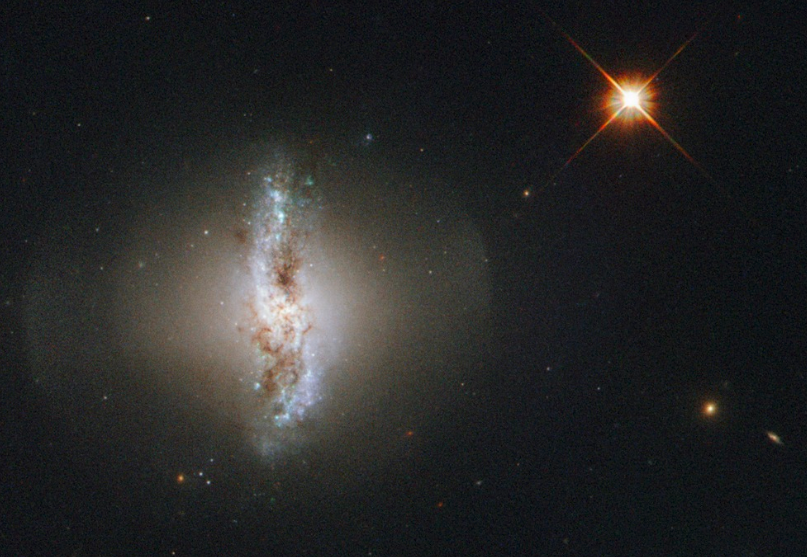I’ve found my calling as a scientific skeptic. I have set out to explore the nether regions of scientific inquiry and to call out the threads that seem to me to have the most validity.
I ask your indulgence for a two-sentence rant. An easy way to build a career as a “skeptic” is to be skeptical only of challenges to the mainstream. I’m thinking of Michael Shermer, Amazing Randi, Richard Dawkins and Eugenie Scott.
For the coming year, I have set myself the ambitious project of exploring topics that are beyond the scope of my present skepticism, to learn as much as needed to evaluate their claims.
I’m already on record endorsing some prominent scientific heresies:
- I got my start debunking the Selfish Gene version of evolution.
- I’ve gone on to be convinced that Lamarckian inheritance extends beyond epigenetics.
- I have visited cold fusion labs and seen their equipment and data with my own eyes.
- I believe the (lab + anecdotal) evidence for parapsychological powers of the mind is overwhelming.
- I believe that the pyramids and other megalithic structures were built by an ancient technological civilization, probably very different from our own.
- I believe Monica Gagliano’s findings that plants can learn and remember
- I believe Robert Jahn’s findings concerning the effect of human intent on what physicists assume is “quantum randomness”.
- And, of course, I believe that chloroquine and ivermectin are safe and effective preventives for COVID, while the mRNA vaccines are not.
My aim is to keep an open mind and follow evidence where it leads. The following claims are radical departures from consensus science that intrigue me, and I hope to invest enough time to satisfy myself whether they have merit. I plan to report my results on this page over the coming months.
Luc Montagnier, a French biochemist, won a Nobel Prize in Medicine for discovering the HIV virus in 1983. Later in life, he conducted experiments demonstrating that a strand of DNA could change the structure of surrounding water, and that the change persisted after the DNA was removed. He claimed that he could extract a radio signal from a stretch of DNA, then reconstruct the specific sequence of DNA using just the radio signal as guide. [write-up by Mae-wan Ho]
On the subject of water memory, homeopathy is an interesting case. It is easy to prove that homeopathy can’t possibly have any effect, since the dosages on which it is based have been diluted down to zero. On the other hand, there are a huge number of anecdotes and several placebo-controlled trials in which homeopathic remedies are demonstrated to be effective. [The Impossible Cure by Amy Lansky]
Wilhelm Reich is best known for orgone boxes. He enraged both Nazi propagandists and the American FDA with claims that insufficient opportunity for orgasm was the root of most chronic illness in modern culture. But his most radical scientific exploration involved “Bions”, microscopic particles extracted from bacteria at very high temperatures, that seemed capable of growing new life when cooled and placed in a growth medium. He identified types of bions that he claimed caused cancer, and others that he thought might have therapeutic value. If Reich the lab scientist can be trusted (as opposed to Reich the theorist), there are big implications for the origin of life and the 200-year-old claims of “spontaneous generation”.
Wallace Thornhill has devoted his career to the Electric Universe theory. His tenets range from the highly plausible to beyond-the-pale. Plausible is that plasma physics and long-range magnetic fields play a much larger role in the large-scale structure of galaxies than our conventional (purely gravitational) models assume. Beyond-the-pale is that the sun has an iron core and that its energy is generated not by nuclear fusion in the core (hydrogen to helium) but by electric currents attracted from beyond the solar system. This video summary seems to be an even-handed treatment.

Dr Thomas Cowan, Dr Sam Bailey and others have questioned the premise that viruses can cause disease. When I first heard this articulated, I retorted that smallpox had wiped out two continents of Native Americans in the 17th Century. In modern times, it is clear to me that a COVID pandemic was caused by a bat virus that had been weaponized in a laboratory. The “no virus” thesis seems too far-fetched to be considered seriously.
A virus is just a strand of DNA wrapped in proteins. Cowan points out that viruses are indistinguishable from the extracellular vesicles that cells routinely export to communicate with other cells of the body and other bodies in the community. When the cell is stressed or diseased, the vesicles it exports carry a warning and signal. So are “viruses” a cause or a result of disease? Both Cowan and Bailey tell stories of researchers who go to great lengths to try to induce disease by making experimental subjects breathe or ingest viral particles — even injecting viruses seems mostly ineffective.
Two outrageous claims about secret technologies
Are there DARPA projects that have developed technologies far beyond anything in our experience or in the open scientific literature? I take the Pyramids as an proof that alternative ways of shaping and moving matter are possible (and were known to people in the deep past). Edward Leedskalnin claimed to have rediscovered how it can be done.
Judy Wood has compiled evidence hiding in plain sight concerning the destruction of the World Trade Center towers on 9/11/01. Most of the mass of the towers turned to dust and never crashed into the ground. Steel I-beams were bent in incongruous shapes. Cars were melted up to half a mile away, and some were melted on one side only. Her book is full of hard-to-explain pictures. She speculates about directed-energy technologies and combinations of mind and machine. Whether or not her explanations are the most plausible, I find her observations compelling.

Peter Kirby wrote a book about a “new Manhattan project” in which the US military is studying weather modification schemes. Fly ash and aluminum oxide are among powders sprayed high into the stratosphere, and clouds of these particles are heated selectively with radio broadcasts from giant antennas. Dane Wiggington has a documentary and a website with current news on artificial hurricanes, droughts, and earthquakes. I don’t discount the possibility that strange weather patterns and earthquakes in unlikely places are man-made.

Skepticism on a grand scale
If I claim Halton Arp is the most interesting character on this list, this is in part because of my background in astrophysics, but it is also true that Arp had impeccable credentials, including a PhD from Caltech and position as chief astronomer at (then) largest telescope in the world. His observations undermine the Big Bang theory that is the framework for all astronomy today.
Since the 1920s, it has been accepted by nearly all astronomers that redshift is a measure of distance from us. Beginning in the 1960s, Arp scanned the sky for pictures of objects that were visibly connected, but which had very different redshifts. When he had catalogued several hundred compelling cases,, he was challenged by his colleagues on the basis that his evidence was “anecdotal”. So he analyzed the distribution of quasars (all of which are high redshift by definition) with respect to active galaxies that are of much lower redshift, and he showed with great statistical confidence that they appear close in the sky.

Why is this monumentally important? The story of an expanding universe and the Big Bang is all built on the finding that far-away galaxies are moving away from us, and the further they are, the faster they are retreating. “Redshift” means that the particular wavelengths of light characteristic of particular chemical elements in the laboratory are not the same when we look out at stars and galaxies in the sky. The ratios of these wavelengths are the same as our familiar laboratory values, but they appear “redder”, displaced (all by the same amount) toward longer wavelengths, toward the red side of the rainbow. In the 1920s, Edwin Hubble measured this effect for thousands of galaxies, and reported [1923] that the smaller, dimmer galaxies had the higher redshifts. The simplest and (now) familiar interpretation of redshift is that it derives from objects moving away from us, and the size of the redshift is related to the speed of recession compared to the speed of light.
Arp was saying that the redshift of objects in the sky is caused by something other than movement away from us. His thesis was threatening the foundation on which the Big Bang theory is built. Hubble actually agreed with him. Arp got his start working with Hubble, and sees himself as carrying forward Hubble’s true legacy.
Arp was at the height of his influence in the late 1970s. His message was so threatening to the astronomical establishment that he was removed from his position at Mt Palomar Observatory, and (as he reports it) he had increasing difficulty placing his photographs and analyses for publication.
I have never seriously doubted the expanding universe, even as I have reported that the details of the Big Bang theory no longer fit the observations. I don’t know what to make of Halton Arp’s work, but I intend to dive into it early in the new year.
I welcome suggestions from you my readers — what else is controversial, perhaps dismissed by the mainstream, but worthy of investigation?

What do you think of the idea that we are in a “infinite fractal” everything we observe, at any scale, is a fractal and every factual can be infinite.Being that we can’t measure this in scientific terms, we can never say it is or isn’t, but it seems to me that simplicity is the rule in everything, this is a simple theory based on observations of matter at every level, large and small that keep going beyond what we can observe. What’s beyond the observable universe? being we can only measure it up to a certain point and because of our limitations as observers we can look no farther, but we know it continues from that point of reference on. Also the Quantum universe the we can observe continues to find fractions of the wave function we observe as particles. We are limited in our ability to find out what the most elementary wave, particle is because we would need a particle accelerator the size of the known universe to try to find it ( even then it would open more questions than answers) We, as humans have to accept that infinity is a simple solution to the question, ” what was the start of our universe, and what is the ending/”. We tend to look at things as having a beginning ( Birth ) and an ending (Death) so it’s hard to envision infinity as being the answer. When we accept that we are part of an infinite fractal and can’t possibility find the answer via the scientific method, we would no longer need research scientists or theoretical physicists to explain it. It is what it is. Simple.